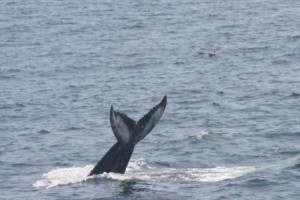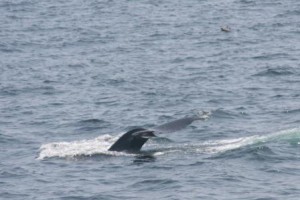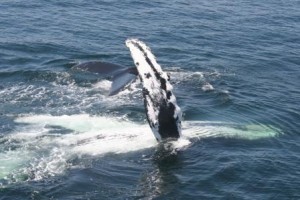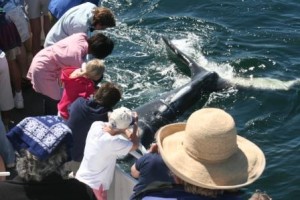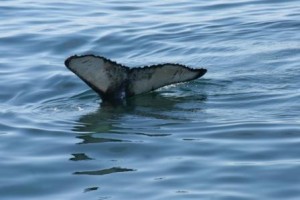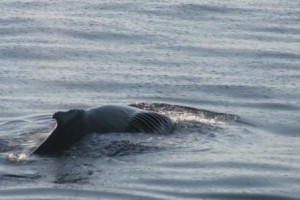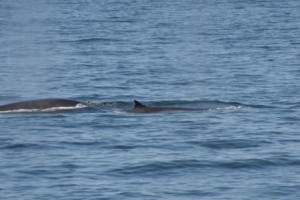Dolphin Fleet Naturalist Notebook 7 June to 13 June
Saturday, June 7 was bright and sunny and the Dolphin VIII started the morning by heading up to the Southwest corner of Stellwagen Bank. It was here that we had our first sighting of the day. Four humpbacks, including Shockwave and her calf, were surrounded birds and were obviously taking advantage of the rich food sources in the region.
Nancy, one of our naturalists, noted Shockwave’s unusual feeding style. “Shockwave is a very cool chin breach feeder and kick feeder, ” she says, “two kicks and a slash of the tail.” Humpback whales will frequently use their tails to stun fish before they swallow schools of them. After watching individual humpbacks, sometimes their individual feeding styles emerge. Shockwave’s calf, while not ready to feed on solid foods yet, seemed to be imitating its mother’s feeding style by periodically kicking and rolling!
Shockwave’s calf
On June 8 we returned to Stellwagen Bank to find that overnight, more humpbacks had gathered along the southern boundary of the bank. Many humpbacks continued to feed, using their powerful tails to concentrate and stun prey. Meanwhile, some of our humpbacks seemed to be through with feeding for the day, and spent much of the morning and afternoon rolling on their backs, slapping their long, white, pectoral flippers on the surface of the water.
The pigmentation on these flippers vary from individual to individual, but in general, humpbacks in the Atlantic ocean have white flipper, while Pacific humpbacks have black flippers. Note the ridges along the trailing edge–these allow the whale to make minute adjustments in movement and steering.
By June 9 the feeding had started back up again. The light winds gave the water a smooth, glassy sheen and we could seen bubble clouds burst to the surface, followed by the wide open mouths of humpback whales. Buzzard, Alphorn, and Agassiz were among the humpback whales seen blowing bubble clouds and feeding this morning.
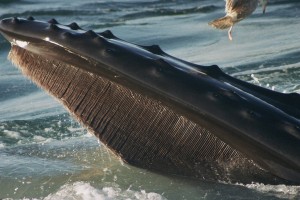
Recent studies on humpback whale feeding suggest that feeding behaviors tend to cycle throughout the day. These studies suggest that humpbacks tend to feed at the surface during the day, while spending more time foraging at the ocean floor at night. While this trend can vary according to time of year, location, and individual, it does seem to correllate with studies on the cyclical distribution of sand lance, the humpback’s food of choice.
June 10 was hazy, hot, and humic–“the three H’s, ” noted Captain John. Luckily, the light ocean breezes provided much-needed respite from the sticky conditions on land. On the morning trip, we found that the humpbacks were still feeding up near the southwest corner of Stellwagen Bank. Isthmus and Agassiz, two mature humpbacks, were among the feeding animals.
By the afternoon, the feeding frenzy had slowed, and the humpbacks, sated from their meal earlier in the day, became a little bit more curious about the boat. As we came to a stop, we were approached by two humpback whales who swam back and forth underneath the boat, frequently pausing to roll on their backs and slap their flippers! The glassy sea conditions gave us a great views of these whales as they peered up at the passengers, who were equally fascinated.
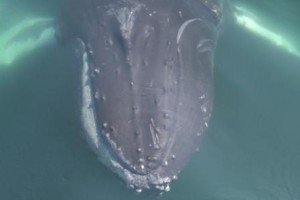
More close boat approaches, or “CBAs” characterized trips on June 11. One particularly notable encounter involved Mural and her calf. Of all the species normally seen on these trips, humpbacks are the animals most likely to approach and interact with the vessel. Like most young mammals, humpback calves are curious and playful, and while their moms are on long dives, they will sometimes stay at the surface to investigate the presence of the boat.
These rare encounterrs can be particularly useful to researchers, as they give us an opportunity to take detailed photo information about the animals. As Mural’s yet unnamed calf slapped its tail and rolled over, we took photos of the whale’s fluke so that we can identify it when it returns next year. Photographs of the whale’s ventral surface can also provide us with information about the whale’s gender.
On June 12 we had a request from the Provincetown Center for Coastal Studies disentanglement team to keep an eye out for a specific humpback whale which had been photographed earlier that week tangled in fishing gear. Although we weren’t able to locate this individual during our trip, the many human-induced threats that these whales face every day remained on our minds.
The Stellwagen Bank ecosystem is important to human and whales alike, and their interests don’t always match. We sometimes find ourselves holding our breath as whales swim near fishing gear, hoping that they will know enough to avoid it, and hoping that the worst doesn’t happen should they encounter it.
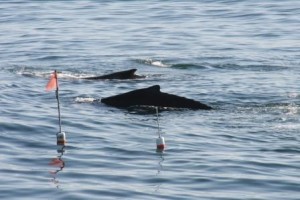
Later in the trip, we were reminded of other threats, as we came across a humpback whale named Pinstripe. Pinstripe has a huge scar down her right side, left behind by the propellers of a boat. Although the scar has healed, it is a frightening reminder of the fragile state of these animals. We were happy to see Pinstripe, however, as she is here this summer with her first known calf!
Due to their gregarious behavior, humpbacks frequently become the focus of our trips, however, it is always a treat to get a chance to see some of the other cetacean species which frequent the area. On Friday, June 13 we were fortunate to get some beautiful looks at the second largest animal on the planet–the fin whale.
While we know quite a bit about humpbacks, particularly as a result of the large amount of photographic data that has accumulated, fin whales are still largely mysterious to us. Do they have distinct migration routes? Where do they end up? Do some stay near Cape Cod year-round or do they have a wider range? These are some of the questions scientists are hoping to answer. One way we are trying to accomplish this is by identifying individuals by the size and shape of their dorsal fins. Scientists on the Dolphin Fleet have been working hard to catalog individual fin whales so that we can learn more about these elusive creatures.






